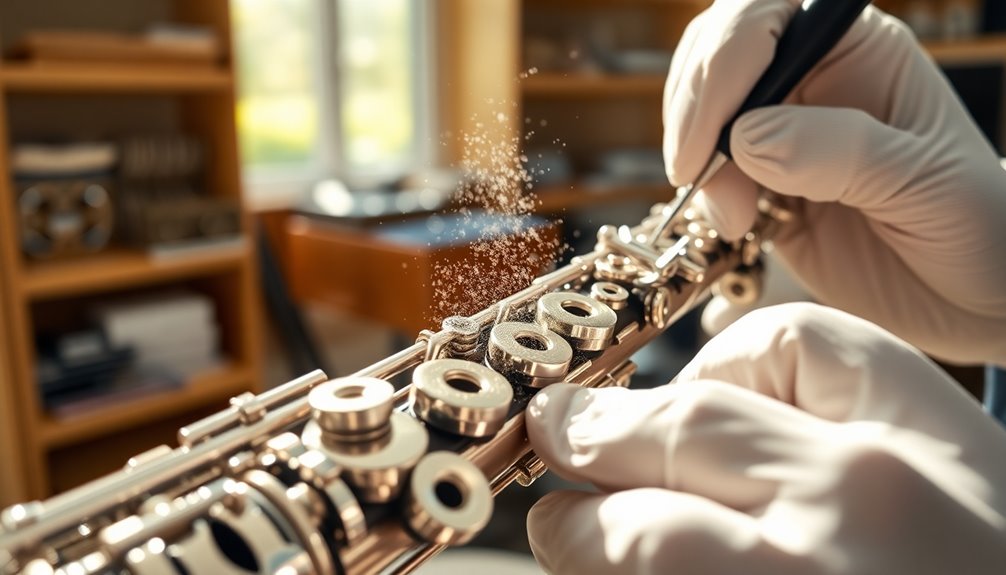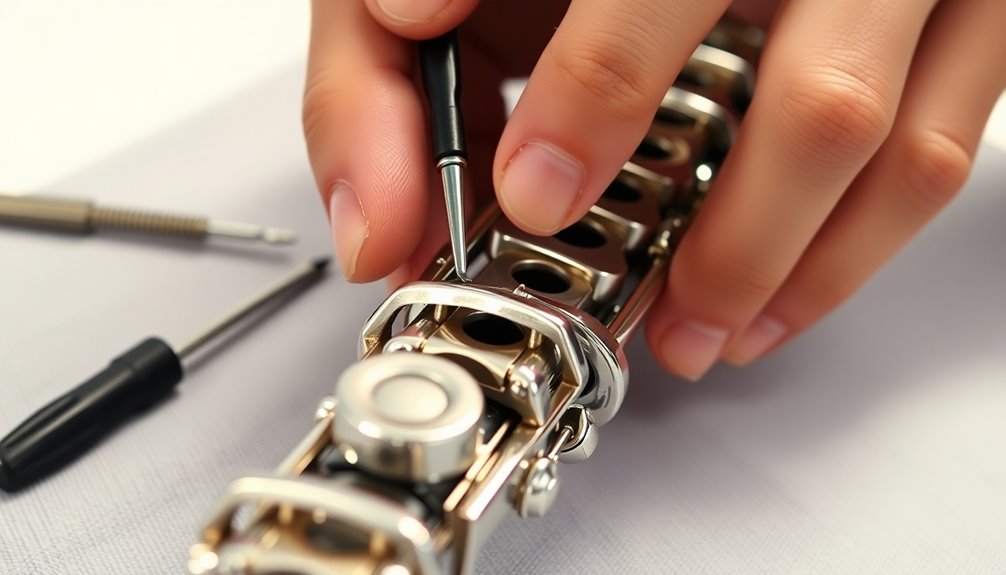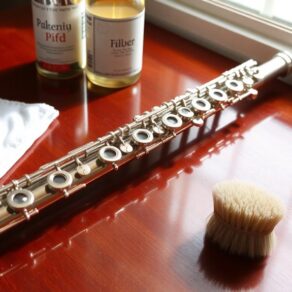To fix common flute problems, start by inspecting your keys and pads for issues like sticking keys or leaky pads, which can severely hinder sound quality. Check the alignment of rods and lubricate pivot points to guarantee smooth operation. Look for cracks in the headjoint or dents in the body; small repairs can often be done at home. Maintain proper tuning by adjusting your embouchure and regularly cleaning your flute to prevent dirt buildup. With consistent maintenance, you'll enhance your flute's performance. Explore further for detailed steps and tips to keep your instrument in top condition.
Key Takeaways
- Regularly check for sticking keys by inspecting pad contact and adjusting alignment with a small screwdriver.
- Inspect and replace leaky pads to ensure proper sealing and sound quality during performance.
- Maintain clean mechanisms by removing moisture and debris using a microfiber cloth and cleaning rod.
- Address structural issues like cracked headjoints with appropriate adhesive or professional repair methods.
- Conduct regular maintenance inspections and use a comprehensive cleaning kit to prolong flute lifespan and performance.
Sticking Keys

When you notice a key sticking on your flute, it can disrupt your practice and performance. It's important to address this issue promptly to guarantee smooth playing.
Start by checking the alignment of the keys. Misaligned keys can lead to unnecessary friction. To do this, close the affected key and observe if it sits evenly against the pad. If it appears off, gently adjust the key's alignment using a small screwdriver. Be careful not to apply too much pressure, as this could cause more damage.
Next, consider employing key lubrication techniques. A light application of key oil can work wonders. Use a small applicator or a cotton swab to apply a thin layer of oil to the pivot points of the keys. Make sure you're using a lubricant specifically designed for flutes to avoid any potential damage.
After applying, move the key gently to distribute the oil evenly. This will help reduce friction and improve key action.
Regular maintenance is vital for keeping your flute in top condition. Make it a habit to check for sticking keys during your practice sessions. If you notice a recurring problem, it might be a sign that your flute requires professional servicing. Additionally, incorporating best practices into your maintenance routine will help prolong the life of your instrument.
By implementing these key alignment tips and lubrication techniques, you'll foster a more enjoyable and productive playing experience, allowing you to connect with fellow musicians and enhance your skills.
Leaky Pads

Many flute players encounter leaky pads at some point, and addressing this issue is crucial for maintaining sound quality and instrument performance.
Leaky pads occur when the pads that seal the tone holes don't create a complete seal, leading to diminished sound production and intonation problems. The first step in addressing a leaky pad is to perform a visual inspection. Check for any visible signs of wear, dirt, or damage on the pads.
If you notice that a pad isn't sealing properly, you might be able to fix it with a pad adjustment. This involves tweaking the mechanism to guarantee the pad sits flush against the tone hole when the key is pressed. Sometimes, simply adjusting the key height can resolve the issue.
However, if the pad is worn out or damaged, pad replacement will be necessary. When replacing a pad, make sure to select the right type and size that matches your flute's specifications. This guarantees that the new pad will fit snugly and create a proper seal.
After installing a new pad, always check the alignment and adjust it as needed to avoid future leaks. Regular maintenance and attention to leaky pads will enhance your flute's performance and prolong its lifespan. Additionally, consider consulting a professional technician for complex repairs, as they can ensure precision in adjustments and pad replacements.
If you're unsure about making these adjustments or replacements yourself, consider consulting a professional technician. They can provide the expertise required for ideal results, ensuring your flute stays in top playing condition.
Cracked Headjoint

A cracked headjoint can markedly affect your flute's sound quality and overall performance. It's essential to address this issue promptly to maintain the instrument's integrity.
Headjoints are typically made from materials like silver, gold, or even wood, each with unique acoustic properties. When a crack forms, it can disrupt the airflow and tonal balance, leading to unwanted intonation issues.
To begin repairs, you'll want to assess the extent of the crack. If it's small and hairline, specialized repair techniques, such as super glue or epoxy, can often suffice. Verify the surface is clean and dry before applying any adhesive.
For larger cracks or if the material is compromised, you may need to consult a professional technician who can employ more advanced methods, such as soldering or replacing the headjoint altogether.
It's also important to take into account the headjoint material during your repair process. Silver headjoints, for example, can be more forgiving and easier to repair than their wooden counterparts, which might require more delicate handling.
Additionally, consider upgrading to a higher-quality flute headjoint to enhance your instrument's performance and sound.
Keep in mind, prevention is key. Avoid exposing your flute to extreme temperatures or humidity, which can lead to cracks. Regular maintenance and inspections can help you catch any issues early on.
Out of Tune

After addressing issues like a cracked headjoint, you might find your flute sounding out of tune. This can be frustrating, especially when you want to play beautifully with others. Here are some common reasons your flute may be out of tune:
- Environmental Factors: Temperature and humidity can affect your instrument's pitch.
- Embouchure Changes: Small adjustments in how you blow into the flute can lead to intonation issues.
- Flute Maintenance: Regular care and minor repairs can impact tuning.
- Mouthpiece Position: Where you place the headjoint can greatly alter your flute's sound.
To tackle these issues, you'll need to employ specific tuning techniques. Start with basic intonation adjustments, focusing on how you position your headjoint. Experiment with slight movements to find the sweet spot that brings your flute back into tune.
Next, play long tones while listening carefully. This will help you identify which notes are sharp or flat. You can use a tuner to guide your adjustments. Pay attention to your embouchure; a consistent and well-formed embouchure helps maintain pitch stability. Additionally, practicing breath control techniques can significantly improve your overall intonation and sound quality.
Lastly, remember to check your flute's mechanism regularly. A well-maintained instrument plays more accurately and stays in tune longer.
Dirty Mechanism

Flute mechanics rely on precision and cleanliness to function effectively, and a dirty mechanism can disrupt this delicate balance. As you play, moisture, dust, and oils from your fingers accumulate, which can lead to sluggish keys and uneven response. To maintain peak performance, it's crucial to adopt proper cleaning techniques and maintenance tips.
Start by removing your flute's headjoint and wiping it down with a soft microfiber cloth. This helps eliminate moisture and prevents buildup.
For the body, use a cleaning rod with a cloth attached, ensuring you reach into the tone holes and pads. Be gentle; aggressive scrubbing can damage delicate components. Regularly check for any debris in the key mechanisms, as this can hinder movement.
It is also advisable to apply a small amount of key oil to the pivots and joints, but remember to use it sparingly. Excess oil can attract dirt, leading to further complications. When applying oil, use a tiny drop and work it into the mechanism with a soft cloth, ensuring it doesn't seep onto the pads.
Additionally, consider a professional cleaning service if your flute hasn't been serviced in a while. They'll have the expertise and tools to disassemble and clean the mechanism thoroughly. Regular maintenance with a comprehensive kit not only enhances your flute's playability but also extends its lifespan, ensuring you can continue to enjoy making music with your instrument. By following these cleaning techniques and maintenance tips, you'll keep your flute in top condition, ready for performance whenever inspiration strikes.
Broken Springs

When you notice your keys not returning to their original position or feeling unresponsive, it could be due to broken springs. Springs are crucial for maintaining the proper spring tension in your flute, allowing keys to function correctly.
If you're experiencing issues, consider the following potential indicators of broken springs:
- Keys remain open or feel sluggish.
- Unusual noises when pressing keys.
- Inconsistent response during playing.
- Difficulty achieving the desired tone.
To address broken springs, you'll need to perform a spring replacement. First, carefully examine each key to identify which springs are damaged. A thorough inspection can prevent overlooking any issues.
Next, you'll want to remove the affected key, which often involves unscrewing it from the body. Make sure to keep track of any small parts, as they can be easily lost.
Once the key is removed, you can replace the broken spring with one that matches the original's specifications. Pay close attention to the spring tension; it's crucial for the key's responsiveness. Regular maintenance, including checking for broken springs, can significantly enhance your instrument's longevity.
If the tension is too loose, the key may not depress fully, and if it's too tight, it could lead to further damage.
Finally, reassemble the key and test its movement. Adjust the spring tension as needed to guarantee it feels natural when playing.
Dented Body

If you notice a dent, inspect it closely to determine its severity. Minor dents can often be repaired at home with care, while more pronounced damage may require professional intervention. For denting prevention, consider investing in a quality case to protect your flute during transport. Make sure that you handle your instrument with care, avoiding any accidental drops or impacts. Additionally, be mindful of your surroundings when playing—tight spaces can increase the likelihood of dents.
When it comes to body repair, you have a couple of options. For small dents, you might use a specialized dent removal tool or a heat-and-cool method to gently coax the metal back into shape. However, if the dent is substantial or affects the tone, it's best to seek a qualified technician. They can assess the damage and use appropriate techniques to restore your flute's integrity. Regular maintenance with a flute cleaning kit(#) can also help prevent moisture buildup that may contribute to such issues.
Ultimately, addressing a dented body isn't just about aesthetics; it's about maintaining your instrument's performance. By being proactive with denting prevention and knowing when to seek professional body repair, you'll guarantee your flute remains in peak playing condition for years to come.
Worn Corks

Over time, corks in your flute can wear down, impacting the instrument's seal and overall performance. A worn cork can lead to air leaks, which ultimately affects your sound quality.
Regular cork maintenance is vital for any flutist who values their instrument. Here are some clear signs that it's time for cork replacement:
- Visible Wear: Check for cracks or rough edges on the cork.
- Air Leak: Notice if certain notes sound weaker or pitchy.
- Loose Fit: Test if the cork moves easily within its housing.
- Deterioration: Look for signs of discoloration or crumbling material.
To maintain your flute effectively, follow these maintenance tips.
First, regularly inspect your corks. A quick visual examination can save you from larger issues.
Second, clean the cork area gently with a soft cloth to remove moisture and debris. Avoid using harsh chemicals that could degrade the cork further.
Third, if you identify that a cork needs replacement, seek a professional technician to guarantee proper installation. It's essential that the new cork fits snugly, maintaining the instrument's integrity. Regular cleaning with a flute cleaning kit can also help prolong the life of your corks.
Finally, consider keeping a cork replacement kit handy for emergencies, especially if you're traveling or performing frequently.
Misaligned Rods

Corks aren't the only components that can affect your flute's performance; misaligned rods can also lead to significant issues. Confirming proper alignment of the rods is essential for smooth operation and peak sound quality. When rods are misaligned, it can result in sticking keys, uneven action, or even damage to your flute. Regular maintenance, including rod adjustment and lubrication, is vital. Additionally, proper maintenance ensures that any potential issues are addressed before they affect the instrument's playability.
Here's a quick reference table to help you identify and address common symptoms of misaligned rods:
| Symptoms | Possible Solutions |
|---|---|
| Sticking keys | Check for rod alignment; adjust |
| Uneven key action | Lubricate rods; confirm proper adjustment |
| Keys not returning fully | Inspect for bends; realign rods |
| Unusual noises | Clean and lubricate rods |
| Increased resistance | Perform thorough rod adjustment |
To address misaligned rods, start by inspecting each rod for straightness and proper positioning. If you notice any bends, gently straighten them using appropriate tools. Next, confirm that the rods move freely; applying a quality rod lubrication can help reduce friction and enhance movement. After adjustments, test the flute's keys to verify they respond correctly.
Frequently Asked Questions
How Can I Prevent My Flute From Getting Damaged During Transport?
To prevent your flute from getting damaged during transport, invest in a sturdy flute case designed to absorb impact.
Use soft padding inside the case to minimize movement, and always secure the flute properly.
When you travel, keep the case upright and avoid placing heavy items on top.
For added protection, consider using a transport cover.
Following these transport tips will help guarantee your flute stays safe and sound on every journey.
What Cleaning Materials Are Safe for My Flute?
What's the best way to guarantee your flute stays in top shape?
For effective flute maintenance, use a soft microfiber cloth for wiping down the exterior and a cleaning rod with a cotton swab for the inside.
Avoid harsh chemicals or abrasive materials that could damage your instrument.
Regularly applying these cleaning techniques not only keeps your flute looking pristine but also enhances its performance, making you feel more connected to your music.
How Often Should I Have My Flute Serviced by a Professional?
You should schedule professional servicing for your flute at least once a year to guarantee peak performance and longevity.
This flute maintenance frequency allows for thorough inspections and adjustments. If you play regularly or notice any issues, consider more frequent check-ups.
Professional servicing tips include keeping your flute clean and avoiding exposure to extreme temperatures.
Regular maintenance not only enhances your playing experience but also fosters a sense of belonging within the music community.
Can Temperature Changes Affect My Flute's Performance?
Just like how a delicate flower wilts in extreme heat, your flute's performance can suffer from temperature effects.
Rapid fluctuations can cause the metal to expand or contract, impacting tone and intonation.
Humidity impact plays a role too; excess moisture can lead to sticky pads and sluggish keys.
To maintain your instrument's integrity, keep it in a stable environment, away from extremes, ensuring it always sounds its best when you play.
What Is the Best Way to Store My Flute When Not in Use?
To store your flute effectively when it's not in use, always place it in a sturdy flute case. This protects it from physical damage and dust.
Incorporate humidity control measures, like silica gel packs, to prevent moisture buildup, which can harm pads and keys.
Guarantee the case is kept in a stable environment, away from extreme temperatures.
Following these steps, you'll maintain your flute's performance and longevity, guaranteeing it's ready whenever you need it.
Conclusion
In addressing these common flute issues, you can restore your instrument's functionality and sound quality. Regular maintenance not only prolongs your flute's life but also enhances your playing experience. Have you considered how a well-maintained instrument can elevate your performance? By tackling problems like sticking keys and leaky pads promptly, you'll guarantee that your flute remains a reliable companion for your musical journey. Remember, a little care goes a long way in achieving the best sound.






